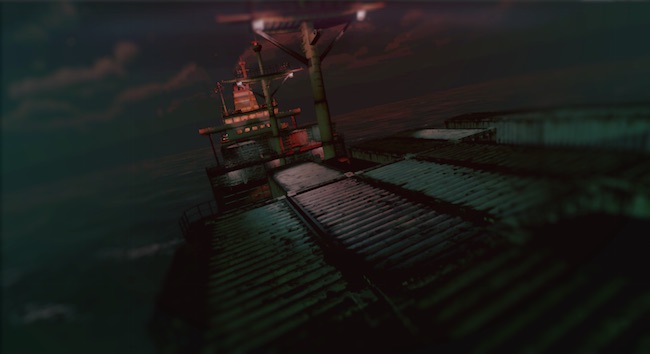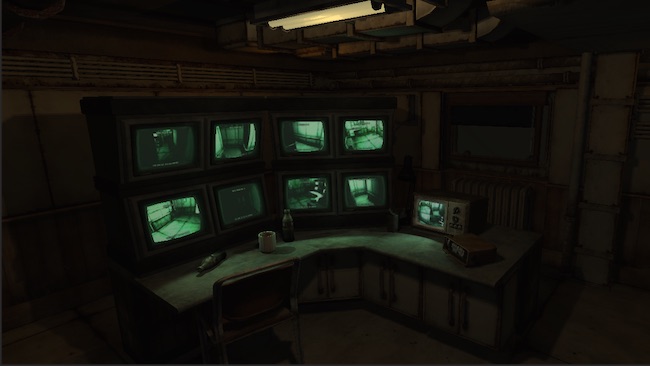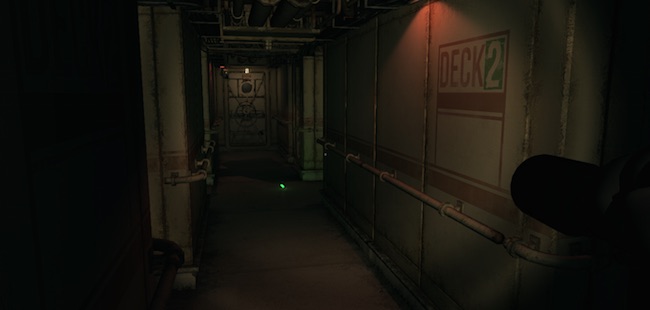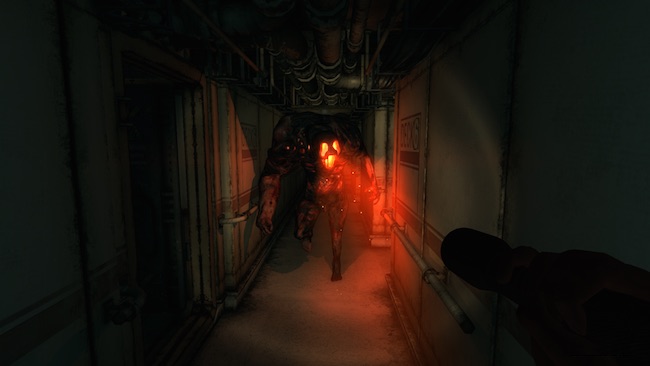
I truly believe we see some of the most daring, innovative and downright brilliant ideas in gaming come to life in the domain of indie developers. Something about the modern indie gaming scene feels like a love-letter to the days of 90’s gaming where pretty much anything went- development teams were small and tight with a shared vision, and getting their unique wares out onto the burgeoning PC gaming market or strong console markets was a fairly straightforward affair. For this reason I’ve very much enjoyed the indie offerings of services like Steam, where independent offerings are plentiful and as colourful as they come; to that end, the mixed-bag offering that Monstrum is feels right at home in the plethora of Steam wares- a flawed, yet ambitious project, it casts the silent player-character aboard an abandoned cargo ship full of randomly generated/placed assets seeking components for a safe escape via one of three methods, while being stalked by one of three unstoppable monsters in a terrifying game of cat-and-mouse.

The narrative component in Monstrum feels flaky at best; the premise is that you’ve woken up in an abandoned cargo ship, only you’re not alone- you’re being stalked by one of three malevolent creatures, all of which will straight-up murder you if falter in your tracks (we’re talking one-hit deaths here, no second chances). But how did this all come to be? Monstrum’s only means of story-telling is by collecting notes left behind by less-fortunate crew members. It’s a little clichéd, but it gets the job done with some of the gaps filled in by environmental storytelling of the surroundings. However, some impact is lost as much of the notes’ content is difficult to place in context; perhaps that’s part of the atmosphere, and it adds to the larger sense of disorientation that Monstrum’s premise seems to lean a little too heavily on.
It also gets a little confusing, as there is numerous mention of other survivors though you never seem to find anyone- this is not all that uncommon in survival horror, though it seems like something of a missed opportunity; it goes without saying that you will die a lot playing Monstrum, and while you will in fact respawn in a new location, with all collectible items now randomly re-generated in to new places, why couldn’t you instead spawn into the previously generated world as one of the new, aforementioned crewmen from the notes who, in the dynamic narrative just decided to try his chances at escaping? It would mean that the previous player-character is now a findable body, complete with all items previously collected just waiting for the next guy to come along. It’d also mean the new player-character already had some objectives completed for him too. As Monstrum doesn’t have any save feature, this would be one way to give the one-time event generation some persistence, and add value to each attempted play through. Strangely, the one thing that is persistent between play throughs is the notes collected.

The concept behind Monstrum is arguably the game’s strongest point, and to that end I feel like it’s worth a place your game library purely on this merit- what we’ve got with each playthrough is basically a single-serve of randomly generated, cat-and-mouse survival horror with item collecting.
What I found downright frustrating was trying to evaluate the significance of player noise on monster behaviour- diegetic sound (sound that exists in the world of the game), particularly in survival horror games is loaded with semiotic significance. Sound tells you about things you can’t see. The tones of the sound give you additional tidbits of information that only a keen listener may pick up on (What was that? Footsteps? They sounded kind of gravelly, where’s the gravel around here?). In games with a stealth component, the player often faces a tradeoff between fast and noisy, or slow and quiet movement. The problem here is that Monstrum never makes it clear whether any of the monsters are particularly responsive to player-noise (crouching vs walking vs running everywhere). Whether walking or running, you’re still producing loud, clomping footsteps that anyone with a generally functional pair of eardrums would hear in a 2km radius. What gets strange, though, is that I hear the exact same footsteps throughout the ship, and there are no clear cues to tell me whether this is just part of the game’s ambience/paranoia building atmosphere, the monster’s presence (which would be strange since they don’t look like savvy customers of leather bound, hard-soled footwear), or whether the footsteps belong to other survivors roaming the ship’s interior.

Gameplay in Monstrum is a mixed bag; at best, the controls felt clumsy and awkward, with inconsistent interactive labelling- collectible items glow, but other interactive objects (drawers, cupboards, switchboxes etc) give no signal that they can be interacted with until you’re pressed up against them, and often camouflage with their surroundings seamlessly before then. The monster behaviour seemed inconsistently responsive; while each of the monsters eke out their unique brand of scaring the living crap out of you, they seem prone to some strange behaviour- glitching out, randomly charging towards your position (despite you drawing no obvious attention upon your location), and inconsistent audio cues are just some of the frustrations to deal with; sure, it’s one way to keep players on their toes and add some jump-scares when the Brute barrels his way into the cabin you’re exploring, but it doesn’t feel fair- in Alien: Isolation, the sounds made by the alien were crucial in evaluating the situation- it had a certain kind of hiss when it had spotted the player; its overhead rattling in the vents sounded different when it was about to drop down, and the pace of its footsteps varied depending on how alert it was to the player’s presence.
Flash forward to Monstrum, while there is some attempt at giving monsters audible cues (the Brute’s loud, heavy footsteps, and his bone-chilling roar when he spots the player), the picture winds up feeling incomplete; there were many times I raced around a corner only to have the 8-foot behemoth standing there with arms wide open- ready to break my neck in complete silence. While I take responsibility for my numerous deaths, it didn’t feel like an entirely fair series of deaths. When the monsters are out of your view, they are extremely difficult to track, and often will roam around in near-silence until they’re too close for you to be able to react appropriately. With no weapons and only a limited number of defensive items, you’re generally better off running and hiding- one section of the ship I explored had something of a lights master switch, which when turned off, made the Brute a little easier to see as his glowing facial features illuminated the corridors around him, though I doubt this would be a viable tactic against other monsters.

A key point to Monstrum seems to be in course memorisation- while the assortment of items and their locations changes with each playthrough (as well as the placement of traps, locked doors and other hazards such as steam valves), the basic geography stays relatively the same. However, this also means the same labyrinthine navigational tedium after each death with no given certainty you’ll find what you need.
Ultimately, this is where Monstrum falls short of expectations; in brief, the game feels unpolished, and essentially unfinished. From choppy monster behaviour, to framerates that inexplicably plummet (despite the visuals looking somewhat previous-gen), means that the experience surmounts to average, showing many missed design and immersion opportunities in its ultimate execution. It would have been great to see some kind of basic crafting mechanics implemented (as so many cabins seem to have fixtures resembling tool benches, power tools and other building hardware), or a little more in-game instruction (via onscreen prompts, or clearer diegetic documentation). I suppose Junkfish were going for something of a trial-and-error style of game with no hand-holding, and while that’s by no means a conceptually bad thing, it would have benefited greatly from some kind of optional save or checkpoint feature.
 High levels of replayability
High levels of replayability
 Well constructed atmosphere
Well constructed atmosphere
 Monsters are well designed
Monsters are well designed
 Short play-time required for completion
Short play-time required for completion
 Missed opportunity for fresh survival horror concepts
Missed opportunity for fresh survival horror concepts
 Inconsistent signals leave players unsure of events
Inconsistent signals leave players unsure of events
 Monsters tend to be erratic and unpredictable
Monsters tend to be erratic and unpredictable
 Lack of polish makes the experience feel fragmented
Lack of polish makes the experience feel fragmented
While promising in concept, and ambitious in its random-asset generation and placement, Monstrum ultimately falls short of the fantastic, rounded horror experience it could have been. It’s creative, spooky and atmospheric, but some of its edges are unfortunately a little too rough for me to give a full-hearted recommendation that you play Monstrum; it’ll certainly appeal to horror fans, and its randomly generated events will add replayability with some genuinely scary moments of heavy, slow-burn dread and pulse-pounding chases, but it all falls a little short of the mark with sloppy presentation and inconsistent AI reactivity.











